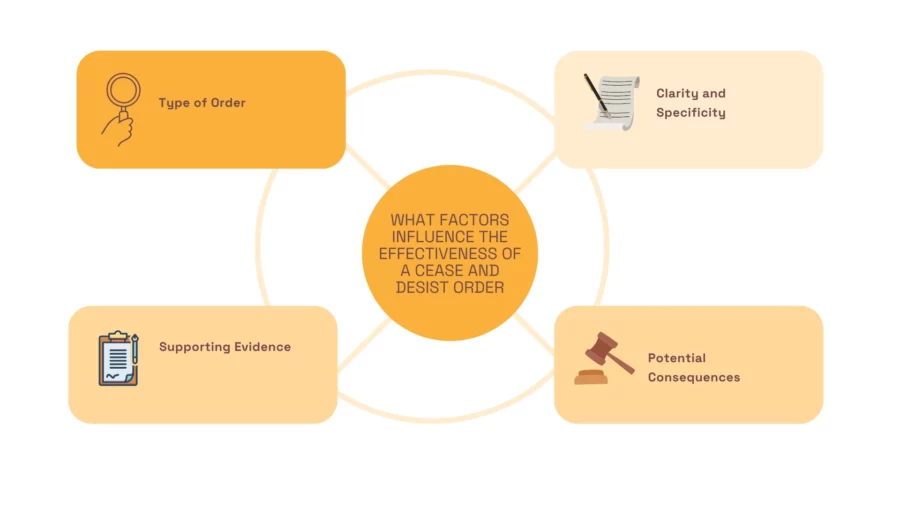Key Takeaways:
- A cease and desist order becomes effective as soon as it’s issued, requiring the recipient to halt specific actions.
- The effectiveness depends on the legal enforcement; if ignored, further legal action can be pursued by the issuer.
- This order serves as a formal warning, often deterring potential infringements or harmful behaviors without immediate court involvement.
A cease and desist order is a powerful legal tool designed to protect individuals or businesses from unwanted behaviors, infringement, or potential harm.
Whether it’s safeguarding intellectual property rights, halting defamation, or addressing a contract breach, this formal notice commands the recipient to immediately stop the specified action. But when exactly does it become effective, and what does “effective” really mean in this context?
The effectiveness of a cease and desist order can depend on various factors, including its legal validity, the recipient’s response, and the potential for further legal action.
Some may wonder if the order immediately holds legal weight or if compliance is optional until pursued in court. Generally, once received, a cease and desist order signals the start of a legal countdown, serving as an initial step toward more serious repercussions if ignored.
Knowing when a cease and desist order becomes effective is essential for both the sender and recipient. This knowledge can help you navigate your rights and responsibilities, whether you’re issuing the order to protect your interests or receiving one.
Let’s dive into the key moments when is a cease and desist order effective and what it means for both parties!
Protect Your Brand & Recover Revenue With Bytescare's Brand Protection software
What is a Cease and Desist Order?
A cease and desist order is a formal, legally binding directive issued by an individual, business, or government agency that instructs a person or organisation to stop engaging in specific actions or behaviors.
These orders are commonly used to address unlawful, harmful, or infringing activities that could potentially damage the rights, reputation, or property of the issuer.
There are generally two types of cease and desist orders: letters and court orders. A cease and desist letter is an official notice sent by an attorney or directly by the affected party, warning the recipient to halt the behavior immediately.
Although it doesn’t carry direct legal enforcement, it serves as a formal warning. Often, this letter is the first step in protecting intellectual property, preventing harassment, or addressing contract violations, allowing for potential swift resolution without court involvement.
A court-issued cease and desist order is legally binding and must be followed. This kind of order comes from a judge and tells the person receiving it to stop doing certain things. If they don’t, they will face legal consequences.
Non-compliance with a court-issued cease and desist order can result in fines, penalties, or further legal proceedings. A cease and desist order is a powerful tool to prevent or stop harmful behaviors without immediately pursuing an extensive legal battle.
It provides an official means to assert one’s rights and can often resolve disputes before escalating to a courtroom setting, making it an essential component of legal self-protection.
Why Are Cease and Desist Orders Used?
A cease and desist order is used to quickly stop activities that could be harmful or violate other people’s rights.
Individuals or businesses can be protected from more harm by these orders, which are an important first step before taking the case to court. Intellectual property infringement, defamation or breach of contract are all common reasons to issue a cease and desist order.
One of the primary uses of a cease and desist order is in cases of intellectual property infringement, such as copyright or trademark violations. By issuing this order, the aggrieved party can formally demand that the infringer stop using protected material, deterring further unauthorised use.
Cease and desist orders are often used in cases of defamation because they help people right away who are having their reputation damaged or who are being troubled by someone else’s actions.
In commercial settings, cease and desist orders are also effective in addressing breaches of contract or preventing unfair business practices, such as deceptive advertising or solicitation of a company’s clients. For many businesses, this order acts as a quick, low-cost way to protect their interests.
Cease and desist orders are powerful tools to stop harmful actions while giving the person who did it a chance to stop on their own. Often, they help settle disagreements quickly and lay the legal groundwork for if more action is needed.
Protect Your Brand & Recover Revenue With Bytescare's Brand Protection software
Is a Cease and Desist Letter a Legal Document?

A cease and desist letter is a formal legal document that tells someone or an organisation to stop doing something that is offending activity or illegal.
While it is not a court order, it holds significant legal weight and serves as an official warning that legal action may be pursued if the recipient fails to comply.
Legally, a cease and desist letter outlines the sender’s rights and the specific actions that need to cease. It typically includes a clear description of the offending behavior, references to relevant laws or agreements, and a demand for the recipient to stop the activities within a specified timeframe.
This document is often drafted by an experienced attorney of a law firm to ensure that it accurately reflects the legal grounds for the demand and to convey the seriousness of the situation.
Although a cease and desist letter itself does not have the force of law, it can be an essential precursor to legal action. Sending such a letter demonstrates that the sender has attempted to resolve the issue amicably and provides a documented record of the dispute.
If the person who gets the letter doesn’t respond, the person who sent it can use it as proof in court to show that they tried to solve the problem without going to court.
Moreover, receiving a cease and desist letter can compel the recipient to reconsider their actions to avoid potential litigation, fines, or other legal consequences. It serves as a powerful tool for enforcing rights, whether related to intellectual property disputes, harassment, defamation, or contractual obligations.
While a cease and desist letter is not a legally binding court order, it is a significant legal document that communicates a serious intent to protect one’s rights and can play a vital role in preventing further legal disputes.
How Does a Cease and Desist Work?
A cease and desist works by formally notifying an individual or organization that they must immediately stop engaging in specific actions or behaviors.
The process usually starts with a cease and desist letter, which is a demand letter issued by the affected party, often with the assistance of a legal professional, urging the recipient to halt their conduct before the matter escalates legally.
The letter describes the offensive actions and any laws or agreements that back the sender’s claim. It usually has a due date that the receiver must meet to avoid more action.
If the letter is effective, the recipient will cease the specified activities to avoid potential costly litigation, penalties, or other consequences. There are many reasons why someone might get a cease and desist letter, such as intellectual property infringement, irreparable harm, or contractual violations.
If the recipient fails to comply, the sender may escalate the matter by seeking a cease and desist order from a court. Unlike a letter, a court-issued cease and desist order is legally binding and enforceable. This order requires the recipient to stop the actions immediately, with legal repercussions if they fail to do so.
A cease and desist letter or order can often resolve disputes without going to court by serving as an initial formal warning. It gives the person a chance to change their behavior on their own without the need of legal battles. This strategic approach protects the rights of the sender most of the time.
Protect Your Brand & Recover Revenue With Bytescare's Brand Protection software
What Are The Types of Cease and Desist Orders?

Cease and desist letters and court-issued cease and desist orders are two primary types of cease and desist orders. Each one does something similar, but they are very different in how legally binding.
Cease and Desist Letter
This type of order is an official written notice typically sent by a business law attorney or directly from the party affected by the recipient’s actions. A cease and desist letter is not legally binding, but it specifies the unauthorized actions that must stop and includes a deadline for compliance.
It is a formal warning telling the recipient that they could face legal action if they don’t stop doing harmful activity.
Cease and desist letters are commonly used in cases of intellectual property infringement, defamation, harassment, or breach of contract, providing an opportunity for the recipient to avoid escalation without court intervention.
Court-Issued Cease and Desist Order
When a cease and desist letter is ignored, the affected party may seek a formal cease and desist order from a court. Unlike a letter, a court-issued order is legal notice and enforceable.
Once issued, it mandates the recipient to immediately stop the offending sort of activity, backed by legal consequences for non-compliance, such as fines or contempt of court charges. This kind of order is only asked for in the worst cases, when other acceptable resolutions have not worked.
Cease and desist letters serve as an initial, non-binding warning, while court-issued cease and desist orders provide enforceable protection, with legal ramifications if the recipient fails to comply. Together, they offer a structured approach for addressing and resolving disputes.
When Is a Cease and Desist Order Effective?
A cease and desist order becomes effective as soon as it is issued, although the level of enforceability and compliance may depend on the type of order. There are two main types: a cease and desist letter and a court-issued cease and desist order, each with different implications for effectiveness.
Cease and Desist Letter
When a cease and desist letter is received, it is effective immediately as an official warning. However, compliance is voluntary, meaning the recipient is not legally obligated to adhere to it, but ignoring the letter can escalate the situation.
In many cases, a well-drafted cease and desist letter, often issued by a lawyer, can be highly effective as a deterrent. Recipients often comply to avoid potential legal action, reputational damage, or additional costs.
While it lacks the binding power of a court order, the letter effectively initiates the legal timeline and may be used as evidence in future legal proceedings if compliance is not met.
Court-Issued Cease and Desist Order
When a cease and desist order is granted by a court, it becomes effective immediately and is legally enforceable. This type of order carries the weight of the law, meaning the recipient must stop the specified illegal behavior or face legal consequences, such as fines or contempt charges.
Non-compliance can lead to further legal ramifications, ensuring that the order’s effectiveness is upheld.
A cease and desist order’s effectiveness is immediate upon issuance, with compliance often dependent on the type. A letter may prompt voluntary compliance, while a court order demands mandatory adherence.
What Factors Influence the Effectiveness of a Cease and Desist Order?

Several factors influence the effectiveness of a cease and desist order, impacting whether the recipient complies and how promptly they take action. These factors include the type of order, clarity of the demand, supporting evidence, legal enforceability, and the potential consequences of non-compliance.
Type of Order
The effectiveness largely depends on whether the order is a cease and desist letter or a court-issued cease and desist order. While a letter serves as a formal warning, it is not legally binding.
In contrast, a court-issued order is enforceable by law and requires immediate compliance, making it more effective in compelling the recipient to halt their actions.
Clarity and Specificity
A well-crafted cease and desist order that clearly defines the alleged infringement, explains the infringed rights, and specifies the required actions increases the chances of compliance.
Ambiguous or vague orders may be ignored or challenged, while detailed orders leave less room for misunderstanding or argument.
Supporting Evidence
Strong evidence to support the claims in a cease and desist order enhances its effectiveness. Clear documentation, such as proof of intellectual property ownership or instances of harmful behavior, can compel the recipient to comply rather than risk a legal dispute.
Potential Consequences
The consequences of non-compliance play a significant role. A court-issued cease and desist order typically carries fines, legal fees, or other penalties, making it more likely that the recipient will comply to avoid these repercussions.
An effective cease and desist order combines clarity, legal backing, and documented evidence, encouraging recipients to comply swiftly and reduce potential disputes.
Legal Requirements for a Cease and Desist Order to Be Enforced
For a cease and desist order to be enforced, especially if it escalates to a court-issued order, certain legal standards must be met to ensure its validity and effectiveness.
These requirements vary depending on the nature of the issue and the jurisdiction, but several common elements are typically needed.
Clear and Specific Language
The order must explicitly state the prohibited actions, leaving no ambiguity about what behavior needs to stop. A well-defined scope is essential for enforcement, as vague or overly broad language can lead to challenges and weaken the order’s impact.
Legitimate Legal Grounds
To secure a court-issued cease and desist order, the issuing party must demonstrate a legitimate legal representation for the demand.
For instance, intellectual property infringement requires proof of ownership and unauthorised use, while harassment claims may require documented evidence of distress or harm. A strong legal foundation bolsters the enforceability of the order and helps avoid dismissal in court.
Supporting Evidence
Extensive evidence supporting the claims is critical for the enforceability of a cease and desist order. Documentation, witness statements, or tangible proof demonstrating the additional harm or infringement can strengthen the order and provide the court with a basis to enforce compliance.
Court Approval
For a cease and desist order to be legally binding, it generally must be issued by a court. This process involves a judge reviewing the claims and determining if the order is warranted, often granting a temporary or permanent injunction.
What Happens If a Cease and Desist Order Is Ignored?

If a cease and desist order is ignored, the consequences can be severe, particularly if the order is court-issued and legally binding.
Ignoring such an order can lead to escalating legal actions, financial penalties, and other serious repercussions. Here’s a breakdown of what may happen:
Legal Penalties
A court-issued cease and desist order carries the weight of the law. If the recipient fails to comply, they could be found in contempt of court, which can result in hefty fines, additional legal costs, or even jail time in extreme cases.
Non-compliance undermines the authority of the court and can lead to further legal consequences.
Further Legal Action
Ignoring a cease and desist order often prompts the affected party to escalate the issue by seeking additional legal remedies.
This could include filing a civil lawsuit proceedings, seeking damages for any harm caused, or pursuing an injunction for continued violations. The original cease and desist order may also be used as evidence of willful infringement or negligence, weakening the defense in future proceedings.
Reputational Damage
Beyond legal consequences, ignoring a cease and desist order can result in significant reputational harm. Whether in business or personal disputes, failure to comply with a formal legal directive can damage credibility, lead to negative publicity, and harm professional relationships.
How to Send an Effective Cease and Desist Order?
Sending an effective cease and desist letter involves several key steps to ensure the message is clear, legally sound, and likely to achieve the desired outcome. Whether you’re issuing a cease and desist letter or pursuing a court-issued order, following these guidelines can increase the chances of success:
Consult with an Attorney
Before sending a cease and desist order, it’s advisable to consult with a lawyer. An experienced business attorney can ensure that your claims are legally valid and help you draft a document that complies with applicable laws. This also ensures you have the appropriate evidence to back your claim.
Clearly State the Offending Behavior
A well-written cease and desist order should clearly outline the specific alleged activity or behaviors that need to stop. Vague language can confuse the recipient and weaken the effectiveness of the order. Include dates, times, and other relevant details to pinpoint the hurtful activity that violates your rights.
Specify the Legal Basis
Include references to the laws, contracts, or agreements that support your demand. For instance, if the issue involves copyright infringement, mention the relevant intellectual property laws. Demonstrating legal concerns strengthens your position and shows that your claim is not baseless.
Set a Deadline for Compliance
Provide a reasonable deadline by which the recipient must cease the specified actions. This timeline gives them a clear window to comply before further action is taken.
Send Via a Secure Method
Send the cease and desist order via a secure delivery process, such as certified mail or a delivery service with tracking, to ensure it’s received and documented.
Follow Up if Necessary
If the recipient doesn’t comply within the given time frame, follow up. If needed, pursue further legal action, such as filing a potential lawsuit or seeking a court-issued order.
How to Respond if You Receive a Cease and Desist Order?
If you receive a cease and desist order, responding carefully is vital to avoid further unintended consequences. Here’s how to approach it:
- Review the Order Carefully: Read the document thoroughly to know the specific actions you’re being asked to stop. Determine the legal basis for the claim and evaluate whether it’s valid.
- Consult with an Attorney: Seek legal advice to assess the legitimacy of the order and understand your rights. An attorney familiar can help determine if the claims are valid or if you can challenge the order.
- Cease the Activity: If the order is legitimate, it’s important to comply by immediately stopping the offending behavior to avoid legal penalties.
- Respond in Writing: If appropriate, send a formal response acknowledging receipt of the order and confirming compliance, or provide an explanation if you believe the order is a false statement or excessive.
What’s Next?
A cease and desist order becomes effective once it is issued, but its enforceability depends on the type of order. A cease and desist letter is effective immediately as a formal warning, though it relies on voluntary compliance.
It encourages the recipient to halt the IP rights violation to avoid further legal action. On the other hand, a court-issued cease and desist order is legally binding and enforceable document, with the recipient required to comply immediately to avoid legal consequences such as fines or contempt charges.
The effectiveness of either order is influenced by factors like clarity, evidence, and potential penalties. Acting promptly and appropriately in response to a cease and desist order can help resolve disputes and prevent escalation.
Bytescare offers global brand protection, ensuring your brand is safeguarded from threats like trademark infringement and unauthorised use worldwide. With our Brand Protection Solutions, geographical boundaries are no longer a concern.
Get comprehensive, worldwide coverage for your brand. Contact us today for unmatched global protection!
The Most Widely Used Brand Protection Software
Find, track, and remove counterfeit listings and sellers with Bytescare Brand Protection software

FAQs
Can anyone send a cease and desist order?
Anyone can send a cease and desist letter, but it is often more effective when drafted by an attorney. A court-issued cease and desist order requires legal proceedings and is enforced by a judge.
What does a cease and desist do?
A cease and desist order demands the recipient stop specific actions or behaviors deemed unlawful, such as infringement, harassment, or defamation, to prevent further harm or legal consequences.
What are the legal positions for a cease and desist letter?
Common grounds include intellectual property infringement, defamation, harassment, breach of contract, unfair competition, or violation of privacy. The letter outlines legal rights and the requested cessation of unlawful actions.
When should you send a cease and desist letter?
Send a cease and desist letter when you believe your rights are being violated, and you want the recipient to stop the infringing behavior before taking further legal action.
What happens after a cease and desist order is issued?
After issuance, the recipient must comply with the order or face legal consequences, such as fines, penalties, or a contempt of court charge. Failure to comply can escalate the issue to court proceedings.
Is a cease and desist letter legally binding?
A cease and desist letter is not legally binding but serves as a formal warning. If ignored, it may precede legal action and be used as evidence in court.
Ready to Secure Your Online Presence?
You are at the right place, contact us to know more.


